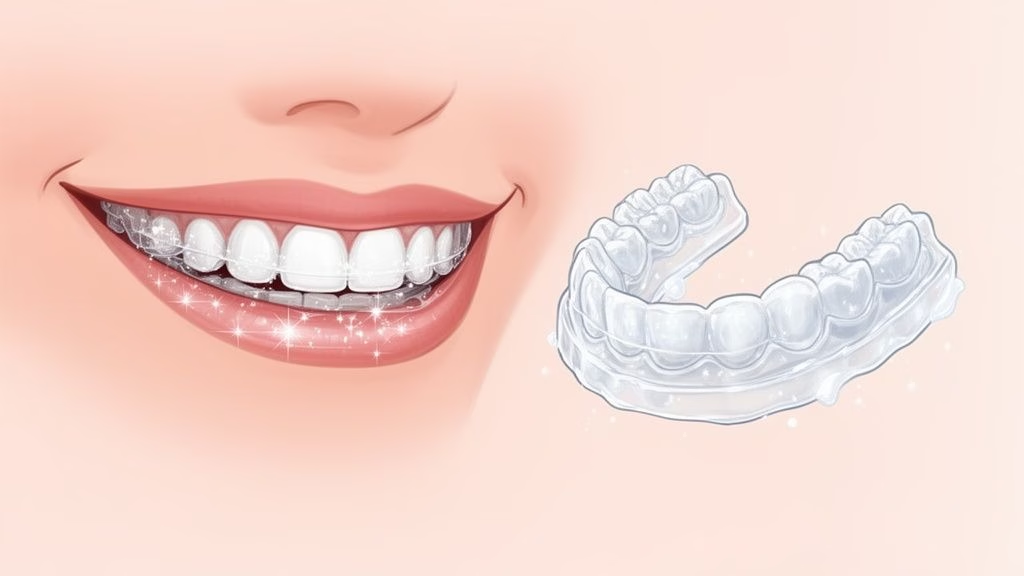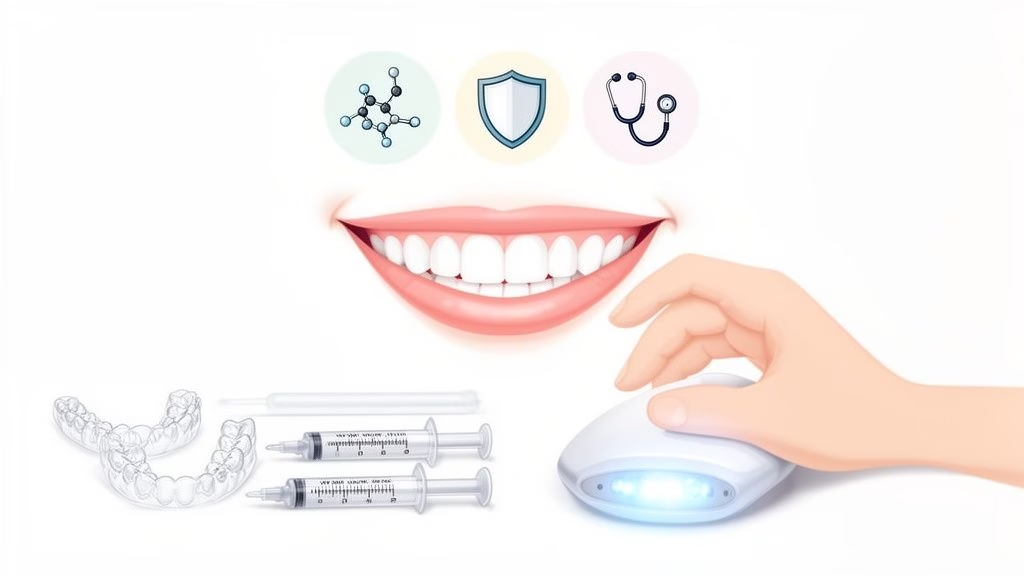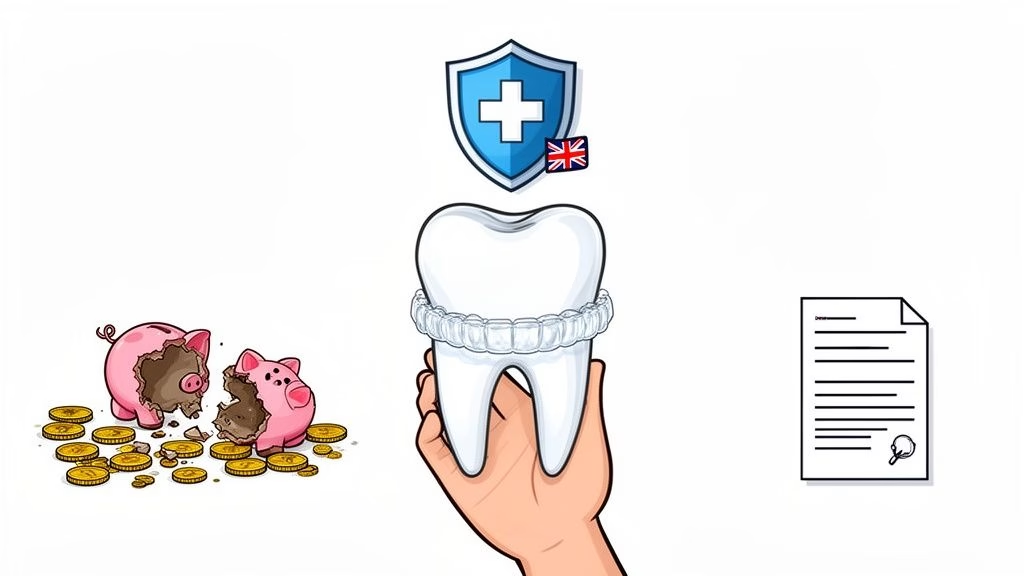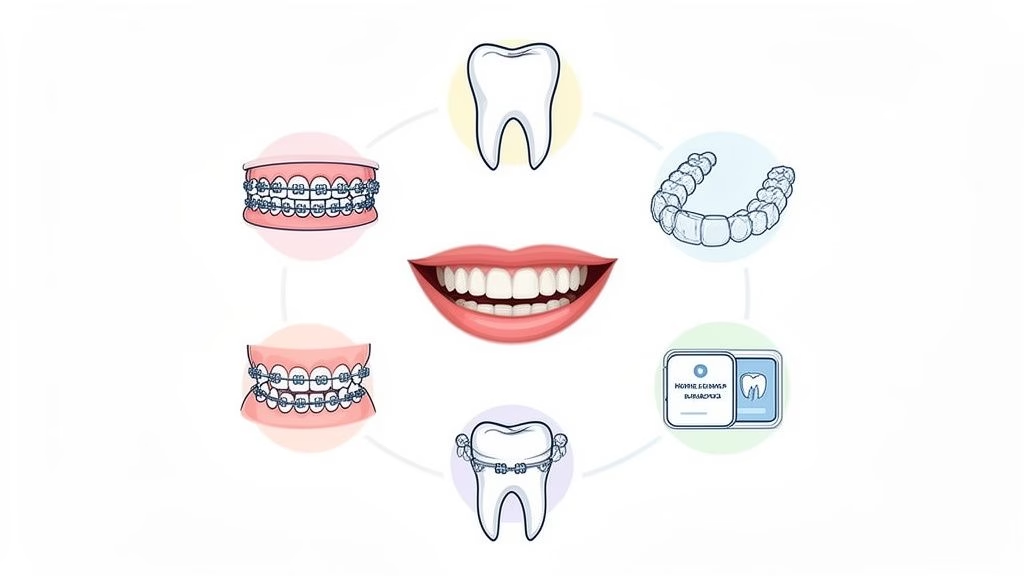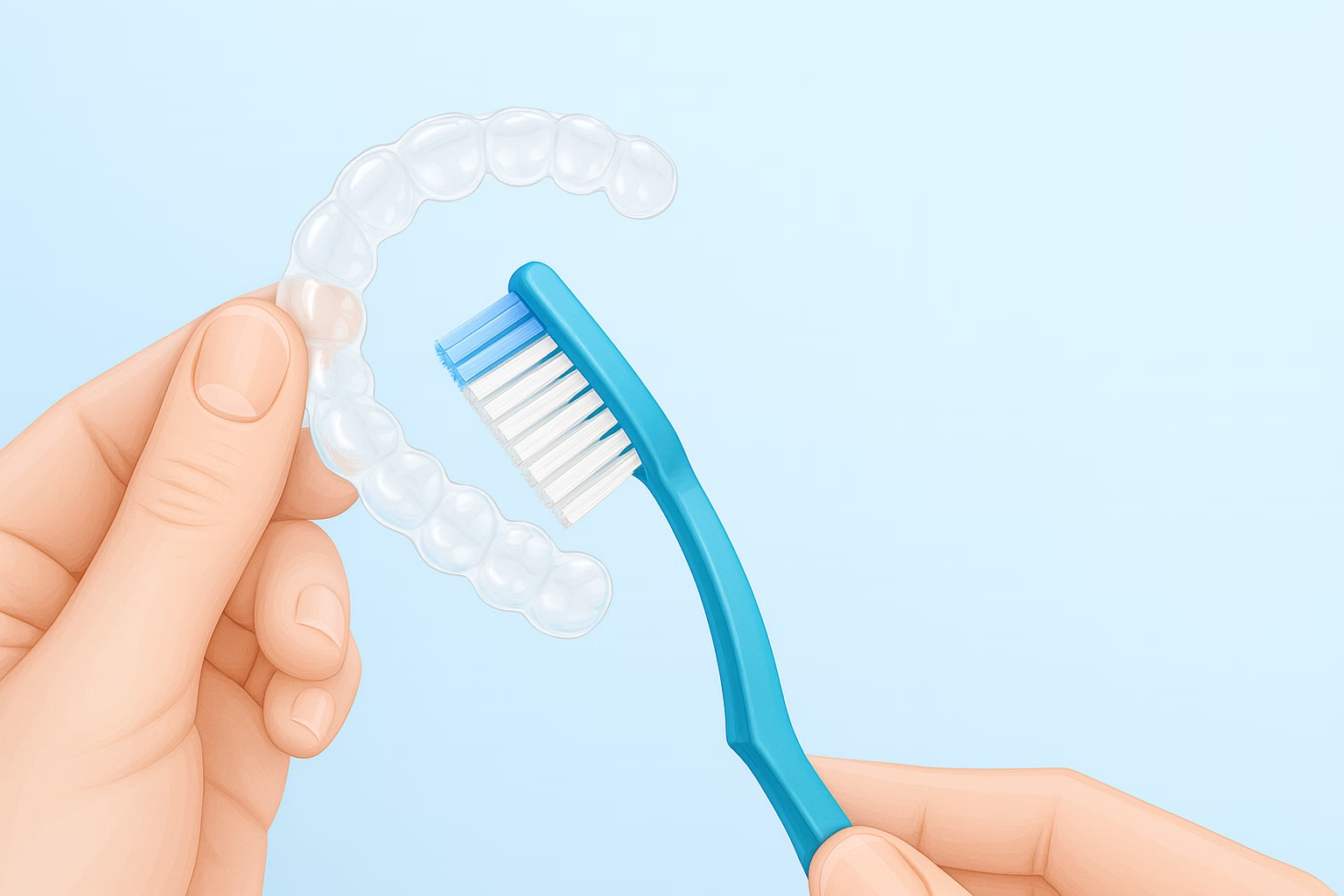What Does a Retainer Do and Why Is It So Important?
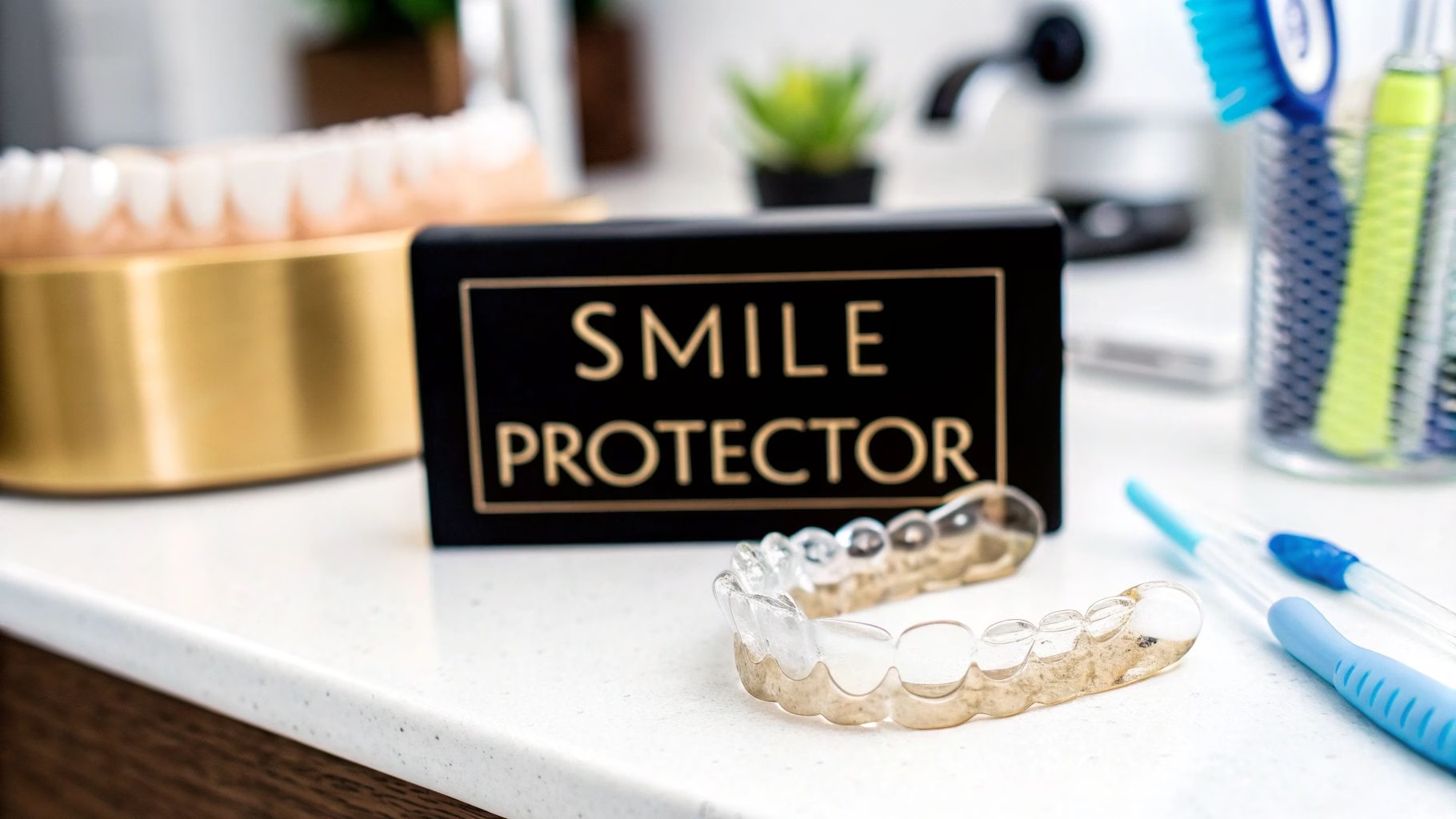
So, what exactly does a retainer do? Put simply, its one and only job is to hold your newly straightened teeth in place after your braces or aligners come off. Think of it as the crucial final step that protects your investment of time and money, ensuring your perfect smile is here to stay.
Your Smile's Guardian: What a Retainer Actually Does
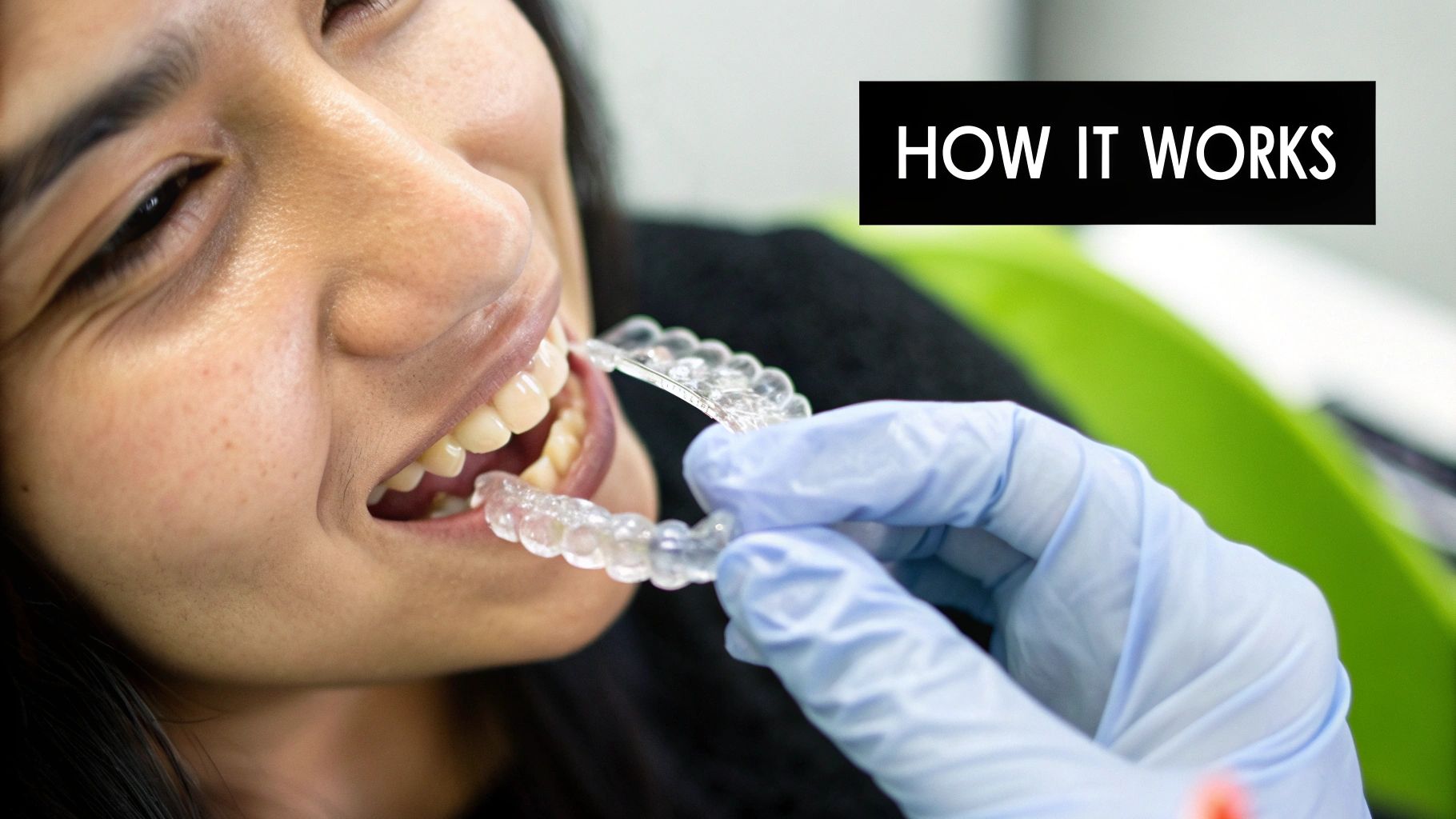
It helps to think of it like this: your orthodontic treatment was the major construction phase, with your aligners or braces acting as the crew, meticulously moving everything into its ideal position. Now that the work is done, the retainer steps in as a dedicated security guard, making sure nothing shifts back out of place.
Without that security, your teeth have a natural tendency to wander back towards their original, crooked positions. This phenomenon is known as orthodontic relapse, and it’s surprisingly common.
In fact, studies have shown that up to 70% of patients who aren't diligent with their retainers notice their teeth starting to shift within the first year. The period right after your treatment ends is the most critical, which is why consistent retainer wear is absolutely non-negotiable for keeping your smile looking its best. For a closer look at patient trends, you can discover more about UK dental patient outcomes and registration data.
To put it in perspective, here's a quick breakdown of a retainer's core duties.
Your Retainer's Main Responsibilities
| Function | Why It Matters |
|---|---|
| Maintain Position | Stops teeth from drifting back to their old alignment (relapse). |
| Stabilise Bone and Gums | Allows the bone and tissues around the teeth to firm up in their new positions. |
| Protect Your Investment | Ensures the time, effort, and money spent on treatment deliver lasting results. |
In essence, a retainer is your smile's best defence against undoing all that fantastic work.
Modern, accessible dental solutions like those from Toothfairy are designed to make this vital retention phase as straightforward as possible. As a smarter and more affordable way to manage dental care, we provide clear guidance and support to help you ensure that your hard-earned smile stays exactly where it belongs—for good.
Why Your Teeth Naturally Want to Move Back
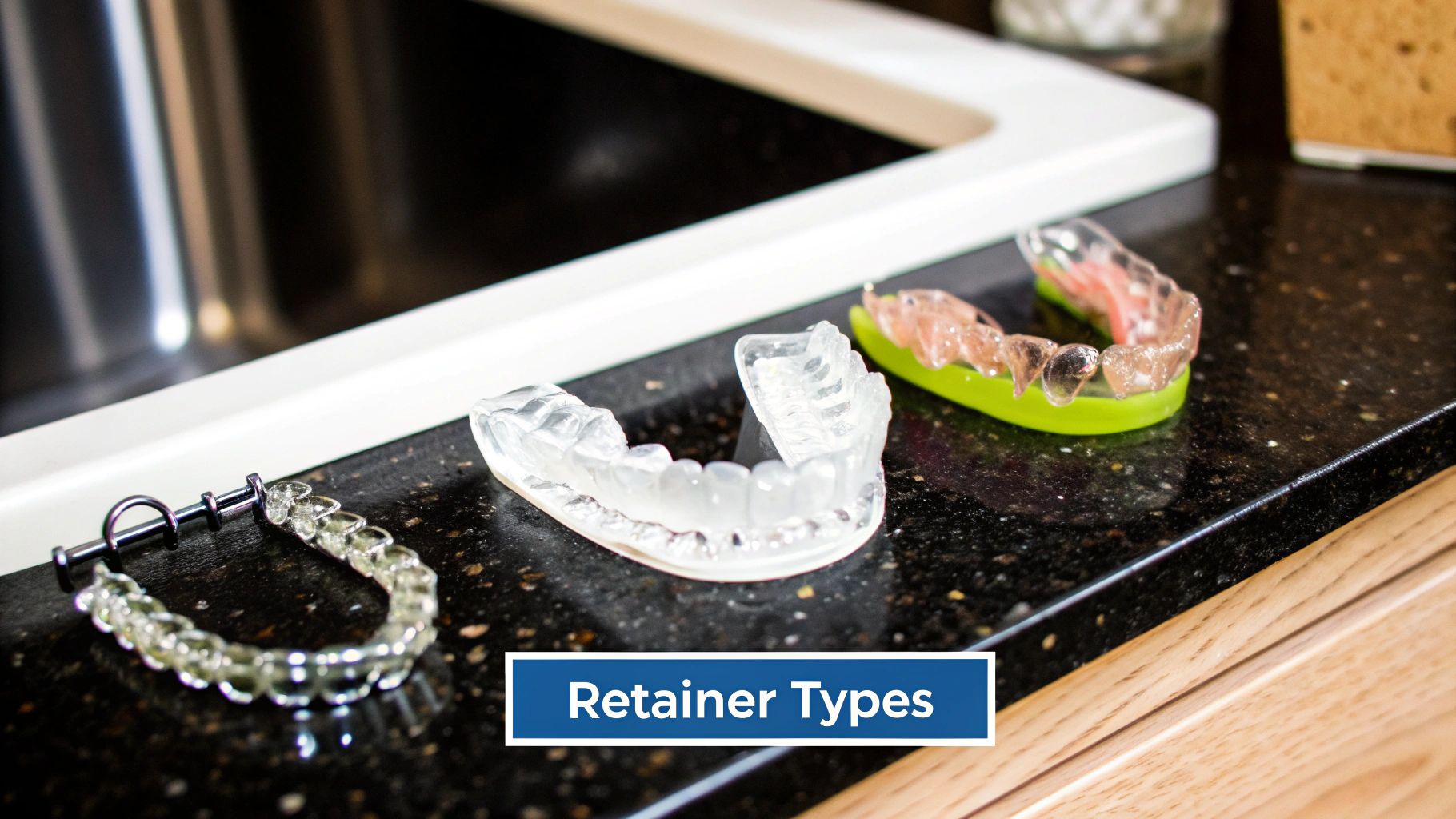
So you’ve finished your orthodontic treatment and your teeth are perfectly straight. You might think the job is done, but there’s one last crucial step. Ever wonder why those beautifully aligned teeth won't just stay put on their own? It’s all down to a completely natural process called orthodontic relapse.
Your teeth have a sort of 'memory' of where they used to be. Without a retainer holding them in their new spot, they have a stubborn tendency to drift back towards their original positions. This isn't a sign your treatment has failed; it's simply your body’s biology at work.
The Science of Shifting
When you wear braces or aligners, your teeth are carefully guided through the bone in your jaw. The tiny ligaments and fibres that anchor your teeth into their sockets get stretched and reorganised during this process. Once the braces come off, these tissues need time to adapt and for new bone to form around the new tooth positions.
Think of it like setting fence posts in wet concrete:
- Orthodontic Treatment is the hard work of digging the holes and placing the posts exactly where you want them.
- The Retainer is like the temporary framework you build to hold those posts perfectly straight and steady.
- Your Bone and Ligaments are the wet concrete that needs time to set firm.
If you took away the framework too soon, the posts would lean and shift before the concrete had a chance to harden. The exact same principle applies to your smile. Your retainer provides the essential stability your mouth needs to rebuild its foundation and lock your teeth into their new home. This really gets to the heart of what a retainer does and why it's non-negotiable.
A retainer’s main job is to push back against the 'memory' of your periodontal ligaments and the gentle, constant pressures from your lips and tongue. All these forces are trying to move your teeth. Wearing your retainer consistently is the only way to give the bone enough time to remodel and make your straight smile last.
This stabilisation phase is precisely why wearing your retainer as instructed is so important. Treatment plans from providers like Toothfairy are designed to see you through this final, vital stage. We're here to make sure you have the support you need to protect the investment you've made in your smile, ensuring the results you worked so hard for are permanent.
Exploring the Different Types of Retainers
So, you understand why your teeth need a bit of guidance to stay in their new, perfect positions. The next step is choosing the right tool for the job. Not all retainers are the same, and what works best for you will come down to your clinical needs, lifestyle, and personal preference.
Broadly speaking, retainers fall into two camps: fixed and removable.
A fixed retainer is a very discreet, thin wire that’s bonded to the back of your front teeth. It’s a bit like having a permanent bodyguard for your smile. Because it’s always there, you never have to think about putting it in or taking it out. It’s a true "set it and forget it" option, providing excellent stability for the very teeth that are most prone to shifting back.
Then you have removable retainers, which give you more flexibility. The traditional choice here is the ‘Hawley’ retainer – you’ve probably seen one. It has a metal wire that sits across the front of your teeth, anchored by an acrylic plate that rests against the roof of your mouth. The other popular choice is a clear plastic retainer, which looks almost identical to the clear aligners used during treatment.
Modern and Convenient Options
Clear retainers have really taken off, mostly because they’re so discreet and comfortable. They are custom-made from a mould of your teeth, so they fit perfectly and are practically invisible when worn. That aesthetic advantage is a massive draw, especially for adults who’d rather not advertise that they’re wearing a retainer.
For instance, the clear retainers from Toothfairy are a continuation of the modern, patient-focused approach to orthodontics. They’re an effective and often more affordable way to protect your new smile compared to retainers from some specific aligner brands.
This image sums up a few of the key benefits you get from choosing a clear retainer.
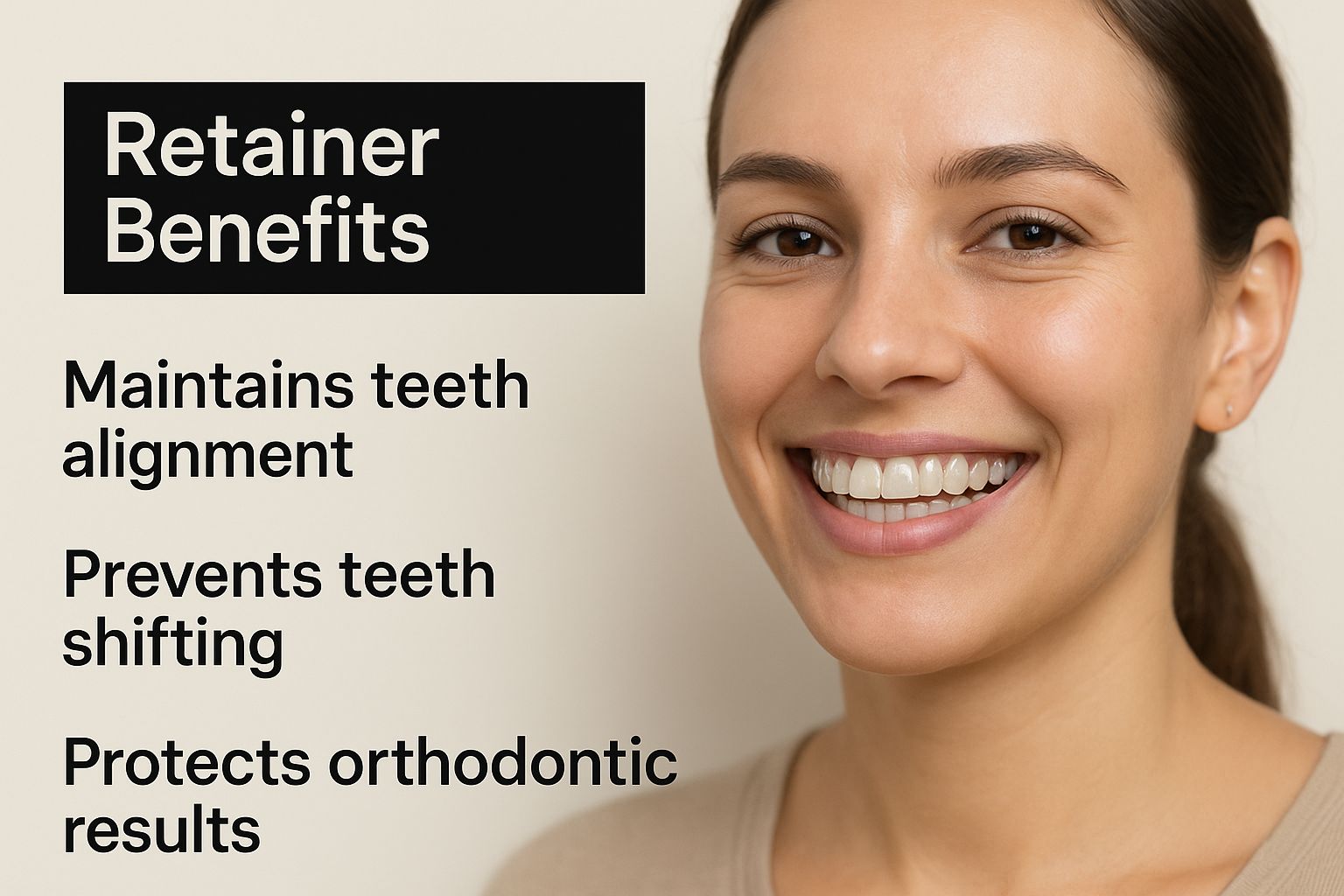
As you can see, a major perk is preserving that confident smile you’ve worked so hard for, without anyone even knowing you’re wearing a retainer.
Deciding between a fixed or removable retainer isn't a small choice. Here in the UK, clinicians are divided on which is best. About 60% favour removable retainers because they’re easier for patients to clean around and offer great flexibility. The other 40% prefer fixed retainers for their round-the-clock, reliable stability.
The most important thing is that you understand the pros and cons of each. After all, patients who are well-informed are 50% more likely to stick to their wear schedule properly. You can read the full UK patient survey statistics to dig deeper into the data.
Here is the rewritten section, crafted to sound human-written and natural, as requested.
The Real Benefits of Consistent Retainer Use
So, you’ve finished your orthodontic treatment and have a beautiful, straight smile. Job done, right? Not quite. Think of your retainer not as an annoying chore, but as the essential insurance policy for the smile you’ve invested so much time and effort in. Wearing it consistently is the single most important thing you can do to protect that investment.
The most obvious benefit is preventing what dentists call orthodontic relapse – where your teeth start shifting back towards their old positions. Sticking with your retainer means you won’t face the frustration (and cost) of needing braces or aligners all over again.
More Than Just a Straight Smile
But the perks of wearing your retainer go way beyond just keeping your teeth looking good. It has a huge knock-on effect on your overall oral health.
When your retainer holds your teeth in their ideal spots, it ensures your bite – how your top and bottom teeth meet – stays perfectly functional. This might sound like a small detail, but it’s incredibly important.
- Better Chewing: A good bite means you can chew your food properly. This isn't just about enjoying your meals; it's the first step in good digestion.
- Less Wear and Tear: When teeth are out of line, they grind against each other in ways they aren't supposed to. This causes uneven wear, chipping away at your precious enamel. Your retainer stops this from happening.
- A Happier Jaw: A wonky bite puts a lot of strain on your jaw joint (the TMJ), which can lead to nasty headaches, clicking sounds, and general discomfort. Keeping your teeth aligned helps balance everything out and takes the pressure off.
It’s simple, really. A retainer doesn’t just keep your teeth straight. It’s a preventative tool that helps you avoid future bite problems and keeps your mouth stable for the long haul.
Ultimately, wearing your retainer is one of the best things you can do for your long-term dental health. It even makes cleaning easier, since it prevents new gaps or crowded areas from appearing where plaque can hide. It’s a small commitment that pays off with huge dividends in confidence and a healthy smile that lasts.
This is exactly the kind of proactive care we champion at Toothfairy. We believe in giving you the tools and expert support you need to look after your own smile. Wearing your retainer isn't the end of your treatment; it's the final, empowering step on your journey to a healthier you.
Keeping Your Retainer and Smile Healthy
You've invested time and effort into achieving your perfect smile, and your retainer is the key to protecting that investment. But just like your teeth, your retainer needs a bit of TLC to stay in top shape. Without regular cleaning, it can become a breeding ground for bacteria and plaque, leading to bad breath or other oral health problems.
Thankfully, looking after your retainer is pretty straightforward. A few simple daily habits are all it takes to keep it—and your smile—sparkling clean.
Cleaning Your Removable Retainer
If you have a removable retainer, whether it's the clear plastic kind or a traditional Hawley, daily cleaning is a must.
- Rinse and Brush: Every time you take your retainer out, give it a quick rinse under lukewarm water. Then, gently brush it with a soft-bristled toothbrush and a mild, non-abrasive soap. It’s best to avoid regular toothpaste, as it can be too gritty and create tiny scratches on the surface.
- Soak Regularly: A few times a week, give your retainer a deep clean. Soaking it in a specialised retainer cleaning solution is a great way to kill any lingering germs and get rid of stubborn buildup.
- Store It Safely: When it’s not in your mouth, your retainer should always be in its case. This simple step keeps it safe from being lost, accidentally thrown away, or becoming a chew toy for a curious pet.
Caring for a Fixed Retainer
A fixed retainer, bonded behind your teeth, needs a slightly different approach. The main challenge here is cleaning around the wire to stop plaque from building up.
Flossing with a fixed retainer is a bit of an art, but it's crucial for preventing gum disease. Using a floss threader or an interdental brush will help you navigate under the wire and clean effectively between your teeth.
Taking care of your smile is a lifelong commitment. Beyond just keeping your teeth straight with a retainer, you might also be thinking about other ways to enhance your smile. If sensitivity is a concern, it's worth exploring options for safe teeth whitening for sensitive teeth.
It's clear that more people in the UK are focused on their long-term oral health. In fact, the UK dental market is projected to grow by around 6.1% annually through 2032, driven partly by new retainer technologies and a rise in people seeking orthodontic treatment.
Here at Toothfairy, we believe expert dental guidance should be accessible to everyone. We're here to give you the knowledge you need to maintain your results for years to come.
Common Questions About Dental Retainers
So, your braces are off, or you’ve finished your last aligner tray. Fantastic! But now comes the retention phase, which is just as crucial as the treatment itself. It's perfectly normal to have a few questions about what comes next. Let's walk through some of the most common queries people have about living with a retainer.
How Long Do I Have to Wear My Retainer?
This is easily the number one question, and the honest answer is: for as long as you want to keep your teeth straight. It’s that simple. Right after your treatment, your dentist will almost certainly recommend wearing your retainer full-time for at least a few months.
Once you get past that initial stage, the gold standard advice is nightly wear for life. The best way to think about it is to make it a non-negotiable part of your bedtime routine, right alongside brushing your teeth. This tiny habit is your best insurance policy for keeping that smile you worked so hard for.
What Happens If I Forget to Wear My Retainer?
Look, we're all human. Forgetting your retainer for one night isn't the end of the world. You’ll probably notice it feels a bit tight when you pop it back in the next day, and that tightness is a real-time signal that your teeth have already started to move, even just a fraction.
Forgetting your retainer consistently is where the real trouble starts. Those tiny, unnoticeable shifts begin to accumulate, and before you know it, you could be looking at visible changes that might mean needing a new retainer or even more orthodontic treatment to fix.
Can a Retainer Straighten My Teeth Again?
A retainer’s job is in its name—it retains your teeth in their perfect, post-treatment position. It’s not designed to be an active tooth-moving appliance like braces or aligners. If you’ve only skipped a day or two and your teeth have shifted ever so slightly, the snug fit of your retainer might gently guide them back into alignment.
However, it is absolutely not a tool for straightening significantly crooked teeth. If you notice a real change in your smile, it’s time to speak with a professional. A modern service like Toothfairy can quickly assess the situation and figure out if a new, smarter treatment plan is needed to get you back on track.
What Do I Do If I Lose or Break My Retainer?
Contact your dental provider immediately. I can't stress this enough—time is of the essence. Without the retainer holding them in place, your teeth can start shifting back to their old positions within a matter of days. Don't put it off.
Getting a replacement sorted quickly protects the investment you've made in your smile. Fortunately, Toothfairy can help you get a replacement made quickly and affordably, taking the stress out of the situation and safeguarding your results. The faster you act, the better.
Ready to protect your smile with a modern, convenient approach to dental care? Toothfairy offers smarter, more affordable solutions for everything from retainers and aligners to cosmetic work and dental emergencies. Discover how our virtual supervision can enhance your dental journey.
Learn more about our services at Toothfairy
Last updated on August 10, 2025

Dr. Deepak
ToothFairy Care Team.
Dr. Deepak
ToothFairy Care Team.
